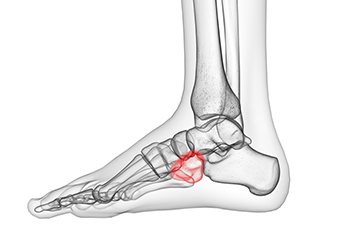
Dr. Kenneth Rosenthal
Dr. Jonathan C. O’Quinn
Dr. Michael J. Price

Dr. Kenneth Rosenthal
Dr. Jonathan C. O’Quinn
Dr. Michael J. Price

Cuboid syndrome is a foot condition that affects the cuboid bone, often resulting in pain and discomfort on the outer side of the foot. This syndrome typically arises from ankle injuries, overuse, or repetitive stress, particularly in athletes engaged in high-impact sports. Symptoms include localized pain, swelling, and difficulty walking or bearing weight on the affected foot. Although cuboid syndrome is not as widely recognized as other foot injuries, it is relatively common among active individuals. Those who participate in sports such as running, soccer, or basketball are at greater risk due to the demands placed on their feet. Understanding cuboid syndrome is vital for prompt diagnosis and treatment. This allows patients to manage their symptoms effectively and return to their activities without prolonged discomfort. If you have pain in this area of your foot, it is suggested that you consult a podiatrist who can accurately diagnose and treat what cuboid syndrome.
Cuboid syndrome, also known as cuboid subluxation, occurs when the joints and ligaments near the cuboid bone in the foot become torn. If you have cuboid syndrome, consult with one of our podiatrists from Eastern Carolina Foot & Ankle Specialists. Our doctors will assess your condition and provide you with quality foot and ankle treatment.
Cuboid syndrome is a common cause of lateral foot pain, which is pain on the outside of the foot. The condition may happen suddenly due to an ankle sprain, or it may develop slowly overtime from repetitive tension through the bone and surrounding structures.
Causes
The most common causes of cuboid syndrome include:
Symptoms
A common symptom of cuboid syndrome is pain along the outside of the foot which can be felt in the ankle and toes. This pain may create walking difficulties and may cause those with the condition to walk with a limp.
Diagnosis
Diagnosis of cuboid syndrome is often difficult, and it is often misdiagnosed. X-rays, MRIs and CT scans often fail to properly show the cuboid subluxation. Although there isn’t a specific test used to diagnose cuboid syndrome, your podiatrist will usually check if pain is felt while pressing firmly on the cuboid bone of your foot.
Treatment
Just as the range of causes varies widely, so do treatments. Some more common treatments are ice therapy, rest, exercise, taping, and orthotics.
If you have any questions, please feel free to contact our office located in Greenville, NC . We offer the newest diagnostic and treatment technologies for all your foot care needs.